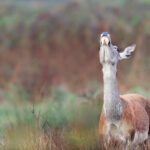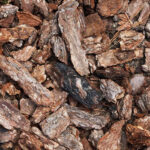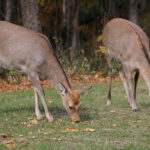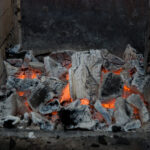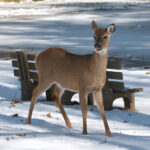In the spring and summer, coyotes build dens underground to raise their pups.
Dens can look very different from each other: sometimes coyotes dig the den themselves, and sometimes they take advantage of burrows already made by other animals or fallen trees.
Here are some tips on how to find a coyote den and what to look for.
Table of Contents
- What Do Coyote Dens Look Like?
- Signs That You Are Near An Active Coyote Den
- Coyote Scat And Urine
- Small Bones And Other Prey Remains
- Where Are Coyote Dens Usually Located?
- Coyotes Will Change Dens If They’re Disturbed
- Finding Dens Can Be A Method To Control Nuisance Coyotes
- How Far Do Coyotes Travel Away From Their Den?
- How Far Do Coyotes Travel Away From Their Den?
- Conclusion
- Related Posts
What Do Coyote Dens Look Like?
Coyote dens look similar to burrows made by other animals: holes dug out in the ground that aren’t always easy to spot if you’re not keeping an eye out for them. The dens are often dug in the ground or underneath tree stumps, but a natural cave can also be used as a coyote home.
Coyote den entrances are larger than those of other burrow-dwelling animals like rabbits and marmots since they have to be big enough to fit an adult coyote.
The holes are usually one to two feet wide, but coyotes sometimes use natural openings created by rocks or logs that are several feet wide.
A den can also have multiple entrances. Some just have one hole as an entrance and exit, but some dens have been recorded to have six that form tunnels leading into a main living area. Dens can reach six feet deep underground.
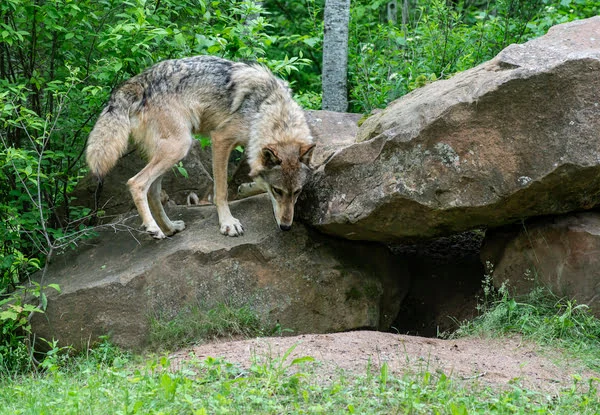
Most dens are camouflaged by whatever natural brush is around since coyotes don’t want their dens to be found by predators or other coyotes. They can be hidden behind shrubs, logs, rocks, and twigs.
Coyotes occasionally raise their pups above ground, although it’s very rare.
These “above-ground dens” look like dents in the foliage where the coyotes sleep, and can only be confirmed as a den if pups are around.
Above-ground denning would only occur in areas where the soil is not ideal for den-making, for example in a moist place with low drainage.
Signs That You Are Near An Active Coyote Den
How do you know if you’re near an active coyote den? Below are some common signs you are in the presence of a coyote.
Coyote Howling
If you hear frequent howling coming from one area, it doesn’t necessarily mean you are near a den, but it is a sign that there are coyotes living in that direction. This is a good start to finding the general area where a den may be located.
Coyote Tracks
If a den is active, there will be fresh tracks coming in and out of the entrance as the mother leaves the den, picks up food the father has left buried outside, and returns to feed her pups.
Coyote prints look much the same as dog prints but are generally more narrow with sharper nails.
Fresh Dirt Dug Up Around The Entrance
If a coyote digs a new den or enlarges an old burrow made by a badger or other animal, there will be dirt mounded around the hole.
Coyote Pups
If you see a young pup, it probably means a den is nearby. Pups emerge from the den about a few weeks after their birth, and they don’t wander far in their first couple of months.
They are born from March to May – keep an ear out for any small whimpers or barks coming from underground.
Even after the den is abandoned, pups and parents will continue meeting in areas near the den for a few more months.

Coyote Scat And Urine
Of course, where there are coyotes living, there will be coyote poop. Coyote scat looks different depending on what prey they eat, but is usually long and cylindrical, often containing fur, berries pieces, and grass.
Coyotes, like domesticated dogs, will mark their territory with urine to defend their den against other coyotes and predators.
Small Bones And Other Prey Remains
Pieces of bone and skin of coyote prey can indicate there’s an active den nearby, but it is not a certain sign.
In most cases, coyotes will keep their den sites clean, especially if they are concerned about predators. In addition, they usually consume prey outside the den, in advance, and regurgitate it for their pups once they return to the den.
Where Are Coyote Dens Usually Located?
Dens are often dug into the side of hills so that the coyotes have a good vantage point to keep an eye out for predators. Coyote dens are usually found in the woods, where they are hidden by shrubs and trees.
They are often located near water sources, such as streams so that the coyotes have easy access to water. Being close to a water body also makes the soil easier to dig into to make the den.
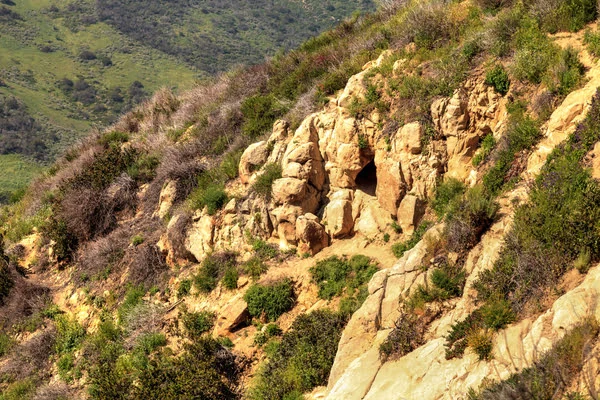
You May Also Like: Can Coyotes Climb Trees? You May Be Surprised!
Coyotes Will Change Dens If They’re Disturbed
Coyotes will build alternate dens in case the safety of their active den is compromised, for example, if a predator finds it. Shortly after a human disturbs the den, coyotes will quickly relocate their pups to another den.
That means there are lots of empty dens that are inactive throughout the season. Pairs usually return to the same den area every year. They may reuse their previous den or build new ones nearby.
Finding Dens Can Be A Method To Control Nuisance Coyotes
If other food sources are scarce, some coyotes may feed on livestock, domestic cats, or other small animals, like possums.
If this becomes repetitive behavior, these coyotes are considered nuisance coyotes.
In these scenarios, the best option for farmers and ranchers may be to remove the coyotes living in their area. Finding coyote dens can be an efficient way to do this.
But it’s important to note that if there are coyotes in your area that are not killing lots of livestock, then the best thing to do is to leave them alone. If you exterminate them, another coyote pack will take its place, and the new coyotes may be even hungrier for livestock.
How Far Do Coyotes Travel Away From Their Den?
Once you’ve located a coyote den, you may wonder how far the coyotes will wander and hunt around it. During the pups’ first few weeks, the adults won’t wander very far at all.
The mother spends most of her time in the den with the pups in the early days. The father hunts and forages for food about six miles around the den, traveling farther as the pups get older. Non-alpha members of the pack may also be around to help provide food for the pups.
How Far Do Coyotes Travel Away From Their Den?
Coyotes are generally close to their den in the early morning. They don’t always sleep inside the den. Especially as the pups get older, they may choose to sleep outside as they normally do during other seasons.
If a den is closer to urban areas, with more humans around, the coyotes will hunt during the night and be closer to their den during the day to protect it from human threats.
Conclusion
During early spring and summer, coyotes will start denning in the woods as pups are born and raised.
Coyote dens can be identified by the size of the entrances (1-2 feet), fresh dirt dug up around the holes and coyote prints in the dirt.
